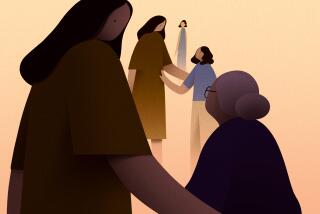‘90s FAMILY : Welcome to ‘Club Grandma’ : There are advice books for wives and husbands, moms and dads. But up until now, grandmoms had to go it alone.
- Share via
Long neglected in the voluminous library of self-help books, grandmothers now have a tome of their own.
“Club Grandma: Etiquette, Privi leges and Official Duties for To day’s Grandmother,” (Longmeadow Press, 1994) by Leslie Lehr Spirson, teaches matriarchs that learning to love being drooled on can be the greatest love of all.
It is a book for the grandmother of the ‘90s who is in her 50s--one who can fix the timer on the VCR but is pressing the snooze bar on her own biological clock. For this group, Spirson has a simple message: “You have fulfilled your genetic imperative by producing future generations. Hold your head high.”
The book--which was co-written by Spirson’s mother, Claire J. Lehr, and was published in June--maps grandmotherly duties from the cradle onward, including practical segments on long-distance bonding, how to tolerate your grandchild’s strange haircuts (not to mention Barney) and the premise, possibly controversial, that kids like to hear about which relatives they look like.
“Grandmotherhood is a well-kept secret,” said Lehr, 57, of Newport Beach. “It’s also a great reward.”
In a recent interview, Spirson, 35, a Woodland Hills resident who also wrote 1991’s “Welcome to Club Mom,” discussed the book and the need to plot a new course for grandmothers in changing times.
Question: There are plenty of books on motherhood, but not many on how to be a grandmother. Many people probably assume that it comes naturally. Why did you write the book?
Answer: When I had my first baby, the relationship that really changed was between my mother and me. She has a Ph.D. in childhood development and soon became the grandmother from hell. She was always wanting to hold the baby when I wanted to, instead of cleaning the house, which is what I wanted her to do. I finally told her, “If you want to come over next week, hand the baby over right now.”
Q: So how did things change?
A: We had a serious talk. When you’re the mother, you become the power person. The mother has to be assertive, so the grandmother must move over and become the queen mother. Once that was worked out, things went fine. (Lehr, who said the situation became a “running joke,” offered a somewhat different assessment: “I was the grandmother from heaven and all my daughter had to do was see the light. One thing people of my generation know is when to step aside and defer to the younger generation. When they have self-esteem, they realize how important we are.”)
In therapy, my mother asks her patients: “Who was it that believed in you?” In a great majority of instances, it was the grandmother. It is the relationship of unconditional love. So the potential for that relationship is very high.
Q: In the book, you emphasize the importance of tolerance--in the early stages, for grandchildren’s imaginary friends and, later on, strange haircuts. How difficult is this to accomplish?
A: For parents, it’s hard. They worry that every little thing their child does will take root. Grandma has been there before and knows that it’s just a stage. She can become like a silent confidante. You know, suddenly I’m calling her for advice. I guess that’s how you know you’re a grandma.
Q: You also mention the importance of sex appeal. You write that grandmothers are caught between two stereotypes, either an old woman with blue hair in a bun or a sexy woman in a tennis outfit. What’s a grandmother to do?
A: I think grandmothers are the sexiest women alive. Not only has she procreated, but her children have procreated. She’s like the mother duck with all these little ducks trailing behind her. When you’re a grandma, you’re at the height, because all the way down the line, everyone is doing it.
As for external shows of sexuality, that’s private. If they want to wear purple miniskirts like Liz Taylor, great.
Q: What is “long-distance bonding”?
A: If the grandmother is far away, this is absolutely essential. In the early stages, babies sense everything with the eyes and nose. Send a scarf with a scent and a big picture that can hang by the cradle. Send tape recordings with favorite lullabies and stories.
Essentially, it is contact. It is really great to have a grandma who will call or send frog postcards in the mail. They can send their grandchildren tapes in envelopes marked “Top Secret,” which the children can listen to on headphones in their room. It’s like a secret club. It is someone who always roots for you.
Q: You contend that grandchildren actually like to hear which relatives they resemble. Is this backed up by serious empirical evidence?
A: Well, you have to make the grandchildren the most important thing. If they can imagine their parents as children or their uncle as a little boy, with the same features, this establishes a very important connection with their family. They can see pictures of their father and hear: “Look at that silly sailor suit.” It’s a way to poke fun at the boss.
More to Read
Sign up for our Book Club newsletter
Get the latest news, events and more from the Los Angeles Times Book Club, and help us get L.A. reading and talking.
You may occasionally receive promotional content from the Los Angeles Times.






